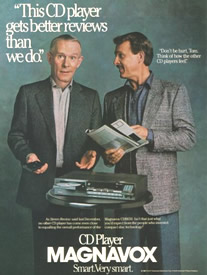Digital audio began in the telephone industry, where it was used to digitize telephone conversations to, in effect, compress them so that multiple conversations could be transmitted at the same time on existing wires. They found that by digitizing sound, they could “process” it to eliminate unnecessary information – an analogy would be a system that saved paper by printing a book with all the white space between the letters removed. One piece of equipment digitally removed the audio “white spaces,” the compressed message was carried down the telephone lines, and a second piece of equipment reconstructed the message in a “readable” (or audible, in this case) form. That’s an oversimplification, but the point is that telephone companies pioneered techniques for digitizing audio, with the goal of reducing the load on their networks. Only later did these companies, and others, experiment with making high quality digital recordings for the music industry.
Some of earliest experiments with digital recording of high quality audio were those undertaken in Japan in the 1960s. Following the introduction of Betamax VCRs, which used a technology for video similar to what was needed to make digital audio recordings, Sony briefly offered an audio-only Betamax recorder, capable of recording audio digitally. This pioneering effort was largely forgotten by the time digital audio tape was reintroduced in the 1980s.

In the meantime, Phillips and Sony (among others) had been working on ways to record TV signals with a laser onto a reflective disc. As with the Betamax, some of the features of video recording are applicable to digital audio recording, so it was not a great leap from the early, analog laser videodiscs introduced in 1978 and later to the compact audio disc, introduced in 1982-3. The CD was not an immediate hit, and it took nearly a decade for it to displace the audio cassette, but in the 1990s it became the most popular home format. Recordable CDs were not generally available until the mid-1990s, and few were sold before about 2000, when their sales took off. There were numerous variations of the CD and digital tape during the 1990s, few of which survived the decade. By the early 2000s, the CD was being challenged by music on DVDs (the same technology used for video), but CDs remained the primary physical medium for commercial music. The real story was about music delivered over the internet and either stored on a device, or “streamed” but not stored by the user at all.
[End]